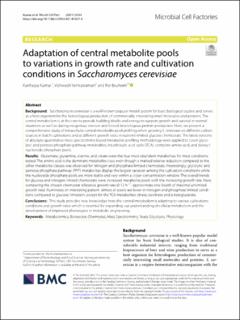| dc.contributor.author | Kumar, Kanhaiya | |
| dc.contributor.author | Venkatraman, Vishwesh | |
| dc.contributor.author | Bruheim, Per | |
| dc.date.accessioned | 2022-12-06T08:12:24Z | |
| dc.date.available | 2022-12-06T08:12:24Z | |
| dc.date.created | 2021-03-11T12:56:31Z | |
| dc.date.issued | 2021 | |
| dc.identifier.citation | Microbial Cell Factories. 2021, 20, . | en_US |
| dc.identifier.issn | 1475-2859 | |
| dc.identifier.uri | https://hdl.handle.net/11250/3035978 | |
| dc.description.abstract | Background
Saccharomyces cerevisiae is a well-known popular model system for basic biological studies and serves as a host organism for the heterologous production of commercially interesting small molecules and proteins. The central metabolism is at the core to provide building blocks and energy to support growth and survival in normal situations as well as during exogenous stresses and forced heterologous protein production. Here, we present a comprehensive study of intracellular central metabolite pool profiling when growing S. cerevisiae on different carbon sources in batch cultivations and at different growth rates in nutrient-limited glucose chemostats. The latest versions of absolute quantitative mass spectrometry-based metabolite profiling methodology were applied to cover glycolytic and pentose phosphate pathway metabolites, tricarboxylic acid cycle (TCA), complete amino acid, and deoxy-/nucleoside phosphate pools.
Results
Glutamate, glutamine, alanine, and citrate were the four most abundant metabolites for most conditions tested. The amino acid is the dominant metabolite class even though a marked relative reduction compared to the other metabolite classes was observed for nitrogen and phosphate limited chemostats. Interestingly, glycolytic and pentose phosphate pathway (PPP) metabolites display the largest variation among the cultivation conditions while the nucleoside phosphate pools are more stable and vary within a closer concentration window. The overall trends for glucose and nitrogen-limited chemostats were increased metabolite pools with the increasing growth rate. Next, comparing the chosen chemostat reference growth rate (0.12 h−1, approximate one-fourth of maximal unlimited growth rate) illuminates an interesting pattern: almost all pools are lower in nitrogen and phosphate limited conditions compared to glucose limitation, except for the TCA metabolites citrate, isocitrate and α-ketoglutarate.
Conclusions
This study provides new knowledge-how the central metabolism is adapting to various cultivations conditions and growth rates which is essential for expanding our understanding of cellular metabolism and the development of improved phenotypes in metabolic engineering. | en_US |
| dc.language.iso | eng | en_US |
| dc.publisher | BioMed Central | en_US |
| dc.rights | Navngivelse 4.0 Internasjonal | * |
| dc.rights.uri | http://creativecommons.org/licenses/by/4.0/deed.no | * |
| dc.title | Adaptation of central metabolite pools to variations in growth rate and cultivation conditions in Saccharomyces cerevisiae | en_US |
| dc.title.alternative | Adaptation of central metabolite pools to variations in growth rate and cultivation conditions in Saccharomyces cerevisiae | en_US |
| dc.type | Peer reviewed | en_US |
| dc.type | Journal article | en_US |
| dc.description.version | publishedVersion | en_US |
| dc.source.pagenumber | 16 | en_US |
| dc.source.volume | 20 | en_US |
| dc.source.journal | Microbial Cell Factories | en_US |
| dc.identifier.doi | 10.1186/s12934-021-01557-8 | |
| dc.identifier.cristin | 1897289 | |
| dc.relation.project | Norges forskningsråd: 237165 | en_US |
| dc.relation.project | Norges forskningsråd: 248885 | en_US |
| cristin.ispublished | true | |
| cristin.fulltext | original | |
| cristin.qualitycode | 1 | |

